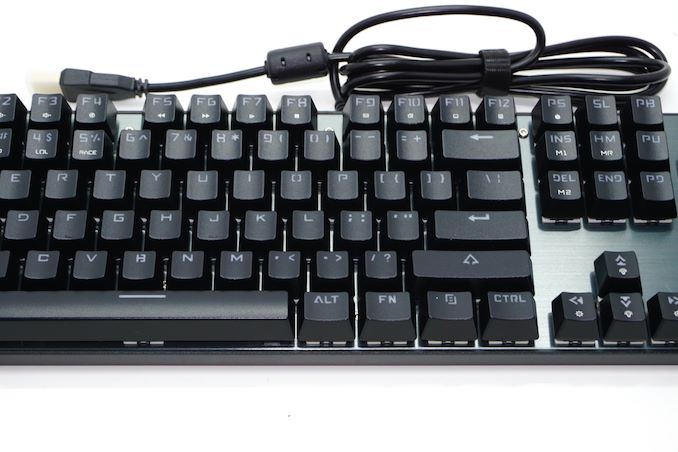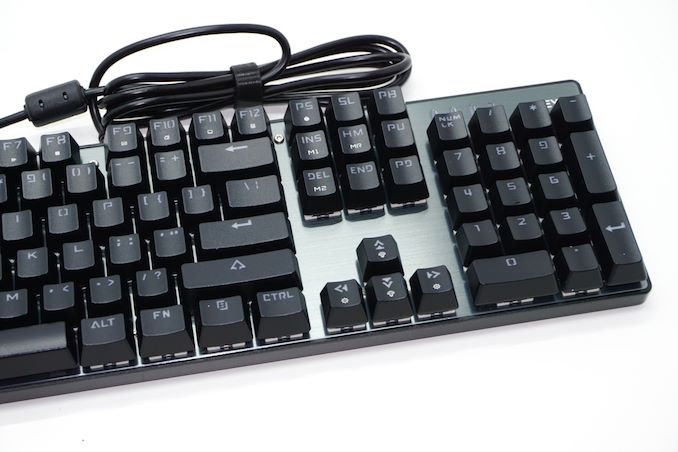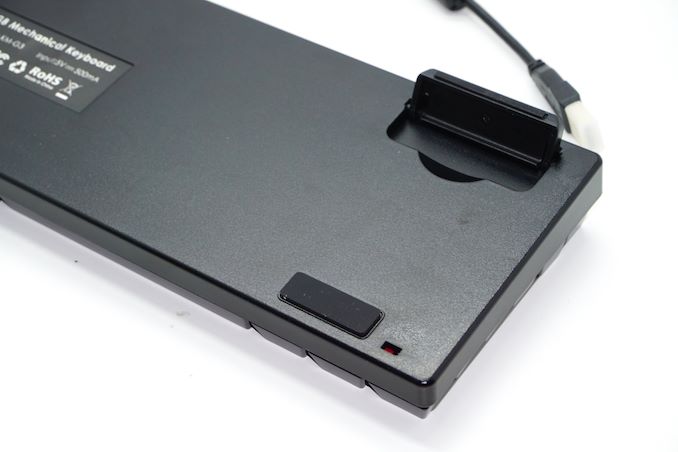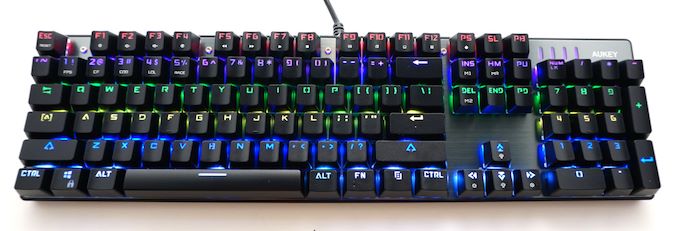The AUKEY KM-G3 RGB Mechanical Keyboard Review: A Basic Budget Mechanical Keyboard
by E. Fylladitakis on October 23, 2019 8:00 AM ESTThe AUKEY KM-G3 RGB Mechanical Keyboard
The KM-G3 shares the same aesthetically simple, minimalistic design of many other mechanical keyboards. It features a thin metallic top cover that acts as a support for the mechanical switches, with the keys “floating” over it. The bottom half of the keyboard is made of plastic. AUKEY reduces the size of the keyboard slightly by moving the top row close to the fifth row of the keyboard, eliminating the typical gap between the function and the numeral rows. Only a basic etching of the company’s logo can be found at the top-right edge of the keyboard – there are no special keys, buttons, or wheels present on the KM-G3.
We received the US layout version of the AUKEY KM-G3 RGB. It basically adheres to the 104 keys ANSI layout, with the exception being the lack of a gap between the two top rows. It has a 6.25× Spacebar and seven 1.25× bottom row keys. AUKEY went with a terminal-like bold font for the keycaps, with both the primary and secondary characters printed near the top of the keycap. The company claims that the keycaps are double-shot ABS and it looks like they are but, unfortunately, we cannot verify their durability within the time frame of a review, as it would take months of significant use for the keycaps to start wearing out.
Some advanced functions are accessible via keystroke combinations using the Fn key. Most are simple multimedia functions, but there is a rudimentary macro recording feature available, allowing for the on-the-fly programming of basic keystroke macros.
The bottom of the keyboard is simple and plain but there is one thing that does stand out – the very large anti-slip rubber pads and wide tilt adjustment feet. We are unsure why the designer went with such large pads because the keyboard is not unreasonably heavy (if anything, it is relatively lightweight) but there are no practical drawbacks to worry about.
Beneath the keycaps of the AUKEY KM-G3 RGB we found OUTEMU Blue switches. OUTEMU is a Chinese manufacturer that effectively copies Cherry’s products, meaning that the OUTEMU Blue switches are an almost direct clone of Cherry’s tactile MX Blue switch. OUTEMU is also using clear plastic for the switch housing, much like what Cherry does with their RGB switch variants. A noticeable design difference are the side supports of the larger keys, with AUKEY using typical bar-type supports whereas Cherry is using their signature cross-type design. We should note that the use of cross-type supports does not necessarily mean that the keyboard is using genuine Cherry MX switches – we have seen many keyboards adopting Cherry’s support design along with OUTEMU or Kaihl switches.
The RGB backlighting of the AUKEY KM-G3 RGB is fairly bright. Although the switches have clear bodies, the lighting is strongly focused to the top of the key and bleeds mostly around the top half of the switch. Unfortunately, the clear body of the OUTEMU switches does little, if anything at all, to evenly diffuse the light around the keycap.
Taking the keyboard apart reveals that the top metal cover of the keyboard actually is very thin and does very little as a mechanical support plate for the keys, as the PCB itself probably is more rigid. The plastic bottom of the keyboard is reinforced and does most of the support work here.
The heart of the AUKEY KM-G3 RGB keyboard is a BYK870 MCU. These microcontrollers are often found in lower cost Chinese-made keyboards and they are a complete mystery, with no information publicly available regarding the controllers or the company – at least not in English. Delving quite a bit deeper reveals that these microcontrollers are fundamentally copies of Sinowealth MCUs, which are mid-performance chips that are also found in low-cost Chinese devices. It is but an 8-bit MCU, which should be good enough for the job considering the rather basic features of the keyboard.



















19 Comments
View All Comments
CU - Wednesday, October 23, 2019 - link
I would like to see a review of the Redragon K550. It is only $69.99 and has software for programming macros and changing the RGB's.RSAUser - Wednesday, October 23, 2019 - link
I have two of the K550, I bought it because I have a K556 as my main work keyboard and it's really good.The K550 is definitely not, keys are slightly louder than my chery brown and the experience is decidedly not uniform across keys, this across both keyboards.
I'd spend the extra if I had to choose again, wasn't worth saving about $20 if e.g. My K556 is 4 years old now and has given no usage issues and been a pleasure to type on. Meanwhile the K550 is just Meh.
Kenshiro70 - Thursday, October 24, 2019 - link
I have a 552 and love it, though I haven't tested the "hot swappable" switches. I'm a little puzzled by the "budget" claim, particularly since both the Redragon and Qisan's MagicForce lines are both well established, well-reviewed on Amazon, and have been updated over time to reflect user feedback. For example, I've seen non-branded versions of the MagicForce offered on Drop, which are greatly appreciated by people doing custom dipping or paint jobs.drexnx - Saturday, October 26, 2019 - link
I was going to say why not just get a real Corsair K68 RGB, it has the best software, cherry MX reds, and a spillproof tray for $79.99 but apparently they're up to $119 now!? guess it's pre-black friday price jumps to advertise bigger sales :\GreenReaper - Wednesday, October 23, 2019 - link
I don't have a good impression of what the "simplistic onboard programming functions" are actually comprised of. Can you create custom.presets to switch to? How many? Per key, or per zone (and what/how many zones)? Is the macro feature the only other programmable/fn feature? (Not counting the multimedia keys.)kpb321 - Wednesday, October 23, 2019 - link
I have to say I don't get the conclusion of the review. If the lack of software severely limits the usefulness of the the true RGB backlight then how can it be a good value for what it is. Features you can't really use aren't worth anything. If you want a mechanical keyboard with rainbow backlights and blue switches you can definitely get cheaper keyboards. If you don't care about the color of the backlight sub $20 is pretty common. I'm typing this on one such sub $20 blue switch mechanical keyboards that happens to have red backlighting.I've got the following that I took into work. Only 1 in stock but rainbow backlight, OUTEMU blue switches for $20 as just one example I happen to have experience with.
https://www.amazon.com/gp/product/B07MNS9WZG/ref=p...
For a true RGB keyboard with software to program it I like the following. Brown switches so similar feel to blue switches but without the audible click. The software is a bit rough and may not be the greatest but it exists, works and has your typical features like per key color control and macros along with multiple profiles. It's now my home keyboard so I don't disturb others late at night.
If anyone still wants this Aukey keyboard it should be $45 after applying code ATKQR9K8 currently.
https://www.amazon.com/dp/B07HK9TKKS/?coliid=IQ4W2...
linuxgeex - Monday, October 28, 2019 - link
You are lucky if you're allowed to have a blue switch keyboard in a work environment. Either you have your own office, or you have an exceptionally noisy work environment such that your keyboard is not annoying your co-workers more than the ambient noise.mobutu - Wednesday, October 23, 2019 - link
I hope you'll soon test this one:https://www.gskill.com/product/155/314/1554280455/...
jabber - Thursday, October 24, 2019 - link
I bought a Aukey mech keyboard (without numberpad) for about £25 on a Amazon special nearly two years ago.I have to say it's been rock solid. No RGB (I'm nearly 50) and the keycaps have remained in perfect shape (I have tough fingernails) with no sign of wear on the letters just a slight shine on the right of the spacebar. They make a good value keyboard!
Delbert91 - Wednesday, November 13, 2019 - link
I'm a little puzzled by the "budget" claim, particularly since both the Redragon and Qisan's MagicForce lines are both well established, well-reviewed on Amazon, and have been updated over time to reflect user feedback. For example, I've seen non-branded versions of the MagicForce offered on Drop, which are greatly appreciated by people doing custom dipping or paint jobs. https://myfedloan.us/